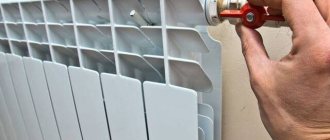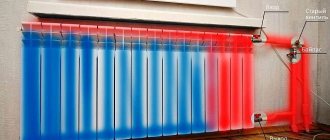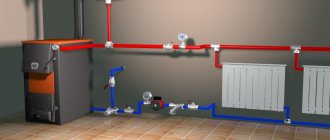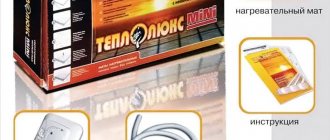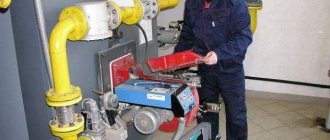Causes
Residents of high-rise buildings had to deal with an unpleasant situation when the heat on the top floors did not reach them at the start of the heating season . There are several reasons for air congestion:
- repair work, such as pipeline dismantling;
- during installation, the slope directions and dimensions of the pipelines were not observed;
- low pressure;
- error when filling the heating system;
- poor sealing of joints - coolant leaks through them;
- connection to underfloor heating;
- malfunction of air intake devices.
In this video you will learn how to remove air from a radiator:
If you live in a private house, you shouldn’t worry too much about a little airiness in the system. The coolant in it is rarely changed, therefore, the air bleeds out on its own after one or two days.
Causes of air
Airing (as this process is also called) can occur due to the human factor or due to a violation of the heating mode technology.
The most likely causes of an air lock:
- Carrying out repair work (assembling and disassembling the pipeline), which inevitably contributes to the accumulation of air.
- Violations during heating installation of the angle and direction of slope of pipelines.
- Reduced pressure in the plumbing system, at which the water level decreases, filling the resulting voids with air.
- The release of air bubbles when water is heated, which rise to the upper part of the pipeline, creating air pockets there.
- Incorrect filling of the highway according to the speed limit.
- Coolant leakage due to poor-quality sealing of pipe joints, resulting in air entering the plumbing system.
- Malfunctions in air intake devices.
Bottom filling with user access
A distinctive feature of the bottom filling is the pairwise connection of heating risers. In this scheme, the supply and return bottlings are located in the basement of the building, and valves are located between them with risers. Either plugs or taps are installed behind the valves, allowing water to be drained if necessary.
During lower filling, the air present in the risers of the system is squeezed out into the upper sections of the risers connected in pairs. On the top floor (usually in apartments, but sometimes in the attic) there is a jumper between the risers, near which a Mayevsky valve is installed, which allows air to bleed from the system.
First of all, residents of apartments on the upper floors need to know how to remove an air lock from a heating system:
- The tap turns 180 degrees and air begins to hiss out of it;
- When water starts flowing from the radiator, the tap must be closed.
When living on any other floor, it will be enough to ask the neighbors above to bleed the air in their free time. If for some reason it is not possible to come to an agreement with the neighbors, you will need to submit an appropriate application to the local housing organization. The main thing is to ensure that the application is accepted in accordance with all the rules, and then if problems arise with heating, it will be possible to request a recalculation in the future.
The need to install automatic air vents
In order to remove air masses from a closed heating system, you can use automatic devices that do not require the participation of anyone. Its performance indicator is at a high level, but the device is extremely sensitive to foreign impurities.
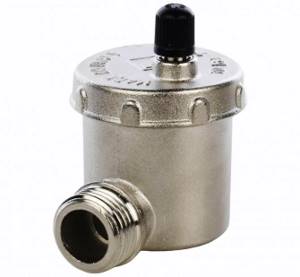
Automatic air vent
You can't do this without special filters. They should be installed on both the return and supply lines. Automatic air mass evacuation devices are equipped with several cleaning stages that will allow you to remove air masses from devices of any category, group or size.
Bottom Filling with Administrator Access - Air Lock Removal
It’s one thing if the problem can only be solved from your own apartment or by contacting specialists. It’s another matter if you can play the role of a specialist yourself, for example, by gaining access to the basement.
The solution to the problem in this case is as follows:
- Before removing air from the heating system, it must be bypassed, for which the heating valve is first closed and the sewer discharge located underneath is opened;
- After completing the previous steps, the system should be given about 5-10 minutes to release air;
- If the desired effect is not achieved, the system must be turned in the opposite direction;
- After bleeding the air, you need to close the vent and return all valves to their original positions so that the heating circuit continues to function as normal.
Individual risers with which problems have arisen can also be transferred from the basement level. To do this, it is enough to close the valve of one of the connected risers and open the discharge. The probability of successful bleeding of air in this case is quite high, and if one of the risers is used as an idle pipe, then the work will certainly be crowned with success.

Even if plugs are installed on the risers instead of vents, there are a couple of ways to get rid of an air lock in the heating system:
- The first option is to shut off both risers, reset them, and then replace one of the plugs with a ball valve with a male-female thread. Of course, this option will require the faucet itself - but its cost is low, and such costs are certainly worth it so that the heating system can continue to operate.
- For the second option, you need to close the valves located on the risers, and then unscrew one plug. The riser is put into reset mode, stops, and then the previous operations are repeated in reverse order. This method of bleeding air can only be used when the coolant temperature is below 45 degrees - otherwise the person performing this work may be seriously burned.
Signs of an airlock and its harm
You can suspect the presence of an air lock in the radiator based on the following signs:
- the air temperature in the apartment is significantly lower than that of the neighbors;
- the battery heats up unevenly - the part in which there is air remains cold;
- Hissing and gurgling sounds are heard.
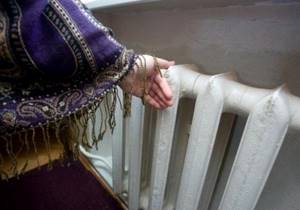
Due to the accumulation of air in the radiator, the operation of the heating system is disrupted. Possible consequences:
- reduction in the effect of battery operation - the air in the room does not warm up to the required level with significant energy consumption;
- damage to pipeline elements due to temperature differences - some parts remain cold, others overheat;
- accelerated corrosion of radiators due to prolonged contact of metal with air;
- failure of the circulation pump under the influence of the “dry friction” effect.
Tip: You can detect air accumulation by tapping the battery with a metal object. In the plugged area the sound will be higher and louder than in the part filled with water.
Top filler with administrator access
If the building uses top filling, this means the following: the coolant supply point is in the attic, and the return circuit is located in the basement. With this configuration, the risers are connected from below and from above, while having the same functional load, so the system maintains an equal temperature within the same floor.
When the circuit is started, air from the radiators moves through the risers into the supply line, and then enters the expansion tank located at the top of the system. Before you bleed air from the heating radiator, you will first need to open the house valves, then go out into the attic and open the tap built into the tank. After some time, the air will simply be squeezed out of the system, and the coolant can continue to circulate calmly. Read also: “How to bleed air from a heating radiator correctly - theory and practice.”

Briefly summarizing, we can say the following - in the absence of experience and understanding of how the heating system works in an apartment building, it is better not to think about how to bleed the air from the radiator yourself. For example, when filling from above, there is a considerable risk of flooding of apartments located on the upper floors, so it is better to entrust such work to specialists from a housing company.
How to bleed air from batteries in a private house
In private homes, a situation may also arise in which air appears in the heating system. What is important is not how the heating system in a private house is aired, but how to get rid of unnecessary air. There is no universal solution to this problem - the heating of a private house is usually designed individually, so the assembled structure has a lot of its own nuances.

However, all types of heating systems have similar features that need to be studied before bleeding air from the battery:
- If the heating has forced circulation, then special air exhaust elements are always installed near the pump (as a rule, they are located either in front of the pump or directly in the boiler). Air in the system in the presence of such elements is most often due to their clogging.
- Air vent valves can also be installed directly on batteries, but only if they are located above the filling point. If the bottling is located somewhere at the upper level, then the air valve should be looked for at its highest point.
- All vertical bends of the filling have their own air vents. If they are absent, you will have to use one of the methods described above to bleed air.
Before you bleed the air from the battery, you need to make sure that the heating system is started correctly - sometimes the reason for its stopping is a valve that is closed in one of the sections.
Causes of air in the heating system
When solving the problem of how to remove air from a heating system, it is useful to study the reasons that cause airing, the main ones being:
- Incorrect installation. In order for water to flow into the boiler with natural circulation, it is necessary to maintain a constant slope when laying pipes. Failure to comply with this condition leads to the appearance of air jams in curved sections.
- Violation of tightness. If defects appear in the heating circuit pipeline in the form of various types of cracks and depressurization of threaded, soldered, and compression connections, air penetrates through them, leading to airing of the entire system.
- Incorrect installation of air vents. Air removal from the heating system of a private house is usually carried out using air vents in heating radiators (Mayevsky taps), on distribution manifolds for underfloor heating and at the highest point of the heating circuit. If these conditions are not fully met, the likelihood of airing the system increases significantly.
- Malfunction of air vents. The coolant may contain products of decomposition (oxidation) of metal components, expired antifreeze or metal salts. The presence of solid suspended particles in the system leads to clogging of the inlet openings, channels of air valves of air vents and makes their normal functioning impossible.
- Failure to comply with the rules for filling coolant. One of the reasons why the heating system in a private home becomes airy is that it is not properly prepared for operation. When filling radiator heating circuits and underfloor heating systems with coolant, simple rules should be followed, otherwise violation of them will lead to the formation of air locks.
- After repair work. One of the reasons why the heating system will vent is air getting into the pipeline after repair or preventive maintenance of individual components. For example, if a circulation pump is removed, redirecting the coolant through a parallel bypass, after installing it in its original position, a problem will arise with the presence of air inside the housing.
- When replenishing the coolant volume. After pouring an additional amount of working fluid into the circuit, the likelihood of airing the pipeline increases due to the fact that the liquid contains a high percentage of dissolved air.
Safety precautions and preventive maintenance
To avoid injuries and other problems, you need to follow a number of rules when bleeding air:
- The rod from the air valve cannot be unscrewed - the pressure of the heated coolant will not allow it to be screwed back on;
- The body of the tap also cannot be turned out - it is very easy to break the thread, but it is difficult to eliminate the consequences of flooding the apartment;
- The radiator caps cannot be unscrewed even partially - they cannot be returned later, and boiling water pouring out of the radiators will bring a lot of negative emotions (about
How long do you need to bleed the batteries?
The duration of the procedure is determined individually. It all depends on the scheme, type of heating, degree of airing. Usually the process is considered complete when the air stops hissing from the tap and the water flows in a steady stream.
The deaeration process is considered complete when water flows steadily from the tap.
To confidently remove the air lock in the heating battery, drain 3 buckets of water through the tap. With this amount of coolant, all the air is guaranteed to escape.
Problem Definition
To identify air pockets in heating you need:
- try to touch the batteries, and if part of the surface is cold or barely warm, this will mean there is air in the system;
- if the temperature in the room drops for no reason;
- if gurgling is heard in the radiator.
It is very easy to check whether the system needs bleeding by tapping a metal object on the top of the battery, and then doing the same at the bottom. Where the traffic jam occurs, the sound will be louder.
How to avoid air locks
It is impossible to completely 100% eliminate the formation of air locks even in modern heating. But you can reduce the likelihood of their formation if you follow a number of rules.
When heating is installed according to the correct design, airing rarely occurs
First of all, you need to correctly install all heating devices and select the optimal heating scheme for a particular building. The batteries are placed strictly horizontally. The pipeline is laid with slopes. Each radiator is equipped with a Mayevsky valve or automatic air vents are installed. Moreover, the unit is additionally installed in difficult sections of the pipeline, where there is a risk of plug formation.
Water is added to the autonomous system through the return line. To do this, a fitting with a shut-off device is provided at the bottom point of the circuit. If the autonomous system is of an open type, the water level in the expansion tank is constantly maintained.
What to do if there is air left
Sometimes after deflating the battery there is no necessary heating. You can fix the problem by blowing or washing the batteries.
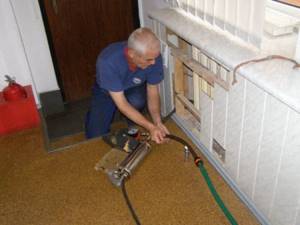
You can fix the problem by thoroughly washing the battery.
With an autonomous system, it is necessary to check that it is completely filled. If the coolant is water, then expansion occurs quite quickly. When temperatures drop, water shortages occur.
If there is a need to drain water through the tank, it is necessary to disconnect the home from heating. The valves are pre-opened.
When the temperature rises, the plug comes out. If this does not happen, you need to boil the water. After this, the air will certainly come out.
Cost of manual and automatic air vents
Prices for air vents for heating systems depend mainly on the metal from which they are made, the manufacturer and the size of the valve. The cost of an automatic air vent can range from several hundred rubles to several thousand for imported devices.
Comparative table of prices of main types and modifications.
| Air vent nomenclature | Cost in regions, retail price, rub/piece, excluding VAT | Cost in Moscow, retail price, rub/piece, excluding VAT |
| Automatic Broen Ballofix (Spain) | 395,00 | 373,00 |
| AE32-17 automatic DN 25 (DN 1) PN40 f | 49 850—50 400 | 49 350 |
| Air bleeder Navien pump Deluxe 13-40K, Deluxe Coaxial | 1000—1200 | 890—1000 |
| Manual air vent FHF-EM (Danfoss) | 710—740 | 705 |
| Manual air vent, simplified | 12,00—15,00 | 11,50—12,50 |
| Manual air vent, 15, for screwdriver | 19,75-22,00 | 18,00—20,00 |
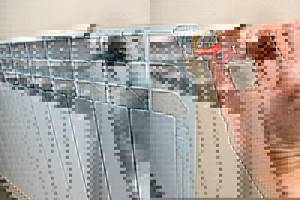
Humidifiers
During the heating period, it is recommended to maintain the indoor humidity necessary for normal living. For this you need humidifiers.
You can make them yourself. There is a lot of information on the Internet to implement this idea. Otherwise, radiator-mounted air humidifiers can be purchased and installed yourself. You can find out how to bleed air from the battery by following this link.

How to avoid air locks
If the heating main is made in accordance with the requirements of GOST and TU (technical conditions), then the appearance of air masses in it is minimized. Another condition to prevent this phenomenon is the correct process of filling the system with water. It has its own characteristics for open and closed heating circuits.
Open circuit
The diagram of an open heating circuit gives an idea of the order in which such a system should be filled with water after flushing. At its highest point there is an expansion tank, and in it there is a special pipe. Its purpose is to protect the highway from overflow.
Such a contour is filled in as follows:
- At the lowest point there is a shut-off valve, through which cold coolant is supplied to the circuit.
- The heating boiler is switched off before filling the system.
- After this, filling of the contour begins. The incoming valve at the bottom of the circuit opens in such a way that the coolant flows in very slowly. In numerical terms, this is expressed in a ratio of 1:3. This means that the valve only needs to be turned back one third of the inlet diameter of the pipe.
- Filling continues until the coolant flows through the overflow hose. Then the water tap is closed.
- Then, air vents are opened on all radiators to ensure high-quality filling of the system.
- The boiler is reconnected. It is advisable to open its taps very slowly.
- The next step is to add coolant at the same slow pace, with the expansion tank filled to 60-70%.
- The operation of the heating system must be checked.
- The boiler is turned on for heating.
- Radiators and pipes are inspected to identify areas where there is no or low heat. This indicates a blockage in the heating line.
- Having identified the cause of airing, the procedure is repeated.
In the first week after connection, the operation of the system is carefully monitored: the water level in the expansion tank, as well as the condition of the radiators and pipes. If necessary, this will allow problems to be resolved quickly.

Filling closed systems
In a similar way, a closed type system is filled with coolant. Water is also supplied to it in a slow flow through a special tap. You can fill the heating system with water yourself.
You should proceed according to the following scheme:
- To perform the procedure, you need a device to measure pressure in the system - a monometer.
- The supply of coolant into the pipeline begins.
- At the same time, pressure is monitored. When it reaches just over 1.5 bar, the supply is turned off.
- Now you can bleed air from all radiators through air vents. In this case, the pressure in the system should begin to decrease.
- The coolant is added in doses to the circuit to maintain it at the required level.
- When the air is completely bled and the line is filled with coolant, the pressure must correspond to the norm. It depends on the specific equipment - from 1.5 to 2.0 bar.
It is optimal to fill a closed contour together with an assistant.
Technology:
- The first bleeds air masses from the radiators.
- The second controls the pressure level in the heating system. If necessary, adds or reduces the feed intensity.
- The first gives a signal about the release of air from the system.
- The partner brings the pressure to the set value.
- The supply stops.

Prevention
Experts recommend doing prophylaxis once a year. Typically this should happen at the beginning of the heating season. This is the only correct way to reliably avoid breakdowns and unnecessarily high heating costs.
For standardized heat exchangers, also called batteries, you need a small wrench with which you can open and close the vent valve. The diverter valve is located on the opposite side of the thermostat. For a heated towel rail in a bathroom, the valve is at the top (rear).
On the front part in the middle of the valve there is a square pin with which the element rotates. If the pin has a slot, you can also use a screwdriver instead of a square wrench. On the side of the valve is a small nipple or tube with a hole that allows water to flow out when opened.
If you have your own heating system or gas boiler in your apartment, you should turn off the circulation pump and wait one hour to allow any existing oxygen in the radiators to collect at the top. When the pump is turned on, it swirls in the system, reducing the likelihood of complete venting. If you cannot turn off the circulation pump yourself (for example, central heating), close the heating system of your apartment.
Once all heat exchangers have been ventilated, install the circulation pump again. If a lot of water is drained, the pressure in the heating system may decrease. If possible, check the pressure on the system gauge and, if necessary, increase the pressure by adding water.
There are several types of heating systems:
- manual. These devices are small in size and are installed on radiators indoors. It is enough to adjust them with a screwdriver or wrench. Due to low productivity, such air vents are used only for local removal within the apartment;
- automatic. Without outside interference. The devices are very effective, but very sensitive.
Places of formation and elimination
It is necessary to bleed air from the battery if there is no doubt about its presence. Gasping is indicated by unexpected gurgling sounds. In addition, the owner begins to notice that the heating is uneven. To restore radiator circulation, air must be removed.
If the system is completely aired, first determine where the plugs are forming by tapping the pipes with a hammer. The sound is stronger and more sonorous in the places where the traffic jam occurs; the areas will also have a lower temperature. Having found a place with air, you need to do the following:
- Prepare a key or screwdriver, as well as a basin for water. The thermostat is opened to the maximum level, then the container is placed.
- Open the valve, making sure that all the water from the inside will flow into the substituted container. You can additionally place rags around.
- The valve must be kept open until all the liquid has drained. A slight hiss indicates air escaping. This means that the manipulations are performed correctly.
- If after the procedure the pipes still do not heat up well, then they need to be blown out and washed - the accumulation of rust inside can also cause air to appear.
Radiator Bleeding Tools
Before starting the necessary manipulations, you should make sure that all the necessary equipment is at hand. There will be no time to look for what you need during the process.
| Required Items | Method of use |
| Unnecessary rags | With their help, you should lay the floor around the battery. If something goes wrong, this will help keep not only your own property intact, but also your neighbor’s. |
| Bucket, basin or any other container | Excess water will be drained into the container. |
| Radiator key | Can be purchased at any hardware store. The size must match the installed battery. A home tool kit can replace a wrench - a wrench of the required diameter. A screwdriver is suitable for deflating air masses. |
To check the battery, just lightly tap its surface with a hammer. If the sound is too loud, there is air there.
Filling the system correctly
The easiest way is to pump water or antifreeze into pipelines connected to an open expansion tank. To do this, you need to open all the valves (except for the drain) and, by attaching a hose to the make-up fitting, fill the lines and radiators with coolant. In this matter, it is important to take your time and allow the air to leave the system on its own through the expansion tank.
Advice. After filling, turn on the circulation pump and boiler, and then warm up all heating devices. Then release the remaining air from them through the Mayevsky taps. Do not forget to bleed the pump before starting, as described above.
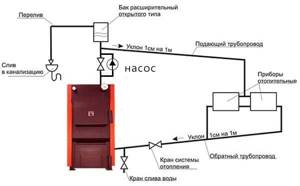
Now about how to bleed air from the radiators and pipelines of a closed heating system in a private house. The proposed technique, constantly practiced by our expert, plumber Vitaly Dashko, is performed in the following order:
- Open all shut-off valves of the main circuits (except for the drain).
- Close all radiator valves, excluding the very last batteries at the ends of the loops, so that circulation occurs through them.
- Get an assistant to do the work. Its task is to be in the boiler room and maintain the pressure in the network at a level of 1 bar using a pressure test pump or through a feed branch from the water supply.
- After opening the water supply, fill the main lines, expansion tank and boiler tank. Air must be released through the safety group valve and air vent at the highest point (if equipped).
- Go to the first radiator from the boiler and open both taps at the same time (slowly). Bleed the air through the Mayevsky valve and close the valves again. The assistant at this time does not allow the pressure to drop below 1 bar.
- Repeat the operation on all batteries, then turn on the circulation pump and start the heat generator. When the lines begin to warm up, open all the radiator valves one by one and remove any remaining air from them again.
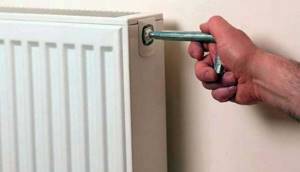
Important point. Before squeezing air plugs out of radiators, be sure to bleed the air from the circulation pump and turn it on for 5-10 minutes to bleed the pipelines.
After the heating devices have completely warmed up, the pressure in the system should be in the range of 1.3-1.6 Bar. At this point the procedure is considered complete. If the system contains heated floors, then they should be filled last, using the same algorithm (on cold floors!). That is, having pumped up the pressure in the main line, you need to alternately open and close the floor circuits, bleeding air through the manifold valves, and then warm up and adjust the coolant flow.
Note regarding the installation of automatic air release valves. Such a device should always be in the boiler safety group, and the second, third, and so on - only when the lines pass above the radiators. With lower wiring in a one-story house, air accumulates in the radiators, since they are located above the pipelines, and it is not necessary to install valves on them.
Where does the air in the system come from?
Practice shows that it is impossible to ideally isolate a water heating network from the external environment. Air penetrates the coolant in various ways and gradually accumulates in certain places - the upper corners of the batteries, turns of highways and highest points. By the way, the latter should be equipped with automatic bleed valves shown in the photo (air vents).

Types of automatic air vents
Air enters the heating system in the following ways:
- Along with water. It's no secret that most homeowners replenish the lack of coolant directly from the water supply. And from there comes water saturated with dissolved oxygen.
- As a result of chemical reactions. Again, water that is not properly demineralized reacts with the metal and aluminum alloy of the radiators, releasing oxygen.
- The pipeline network of a private house was initially designed or installed with errors - there are no slopes and loops are made that face upward and are not equipped with automatic valves. It is difficult to remove air accumulations from such places even at the stage of filling with coolant.
- A small amount of oxygen penetrates the walls of plastic pipes, despite the special layer (oxygen barrier).
- As a result of repairs with dismantling of pipeline fittings and partial or complete drainage of water.
- When microcracks appear in the rubber membrane of the expansion tank.
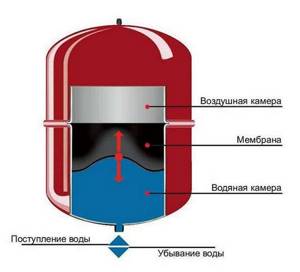
When cracks occur in the membrane, gas mixes with water
Note. Water taken from wells and shallow wells is prone to chemical reactions, since it is saturated with active salts of magnesium and calcium.
Also, a situation often arises when, after a long period of inactivity during the off-season, the pressure in a closed heating system decreases due to air ingress. Draining it is quite simple: you just need to add a couple of liters of water. A similar effect occurs in open-type systems if you stop the boiler and circulation pump, wait a couple of days and start the heating again. As the liquid cools, it contracts, allowing air to enter the lines.
As for the centralized heat supply systems of apartment buildings, air penetrates into them exclusively along with the coolant or when the network is filled at the beginning of the season. How to deal with this - read below.
Example from practice. It was necessary to remove air pockets from the open heating system every day due to a completely clogged mud trap. A working pump created a vacuum in front of itself and thus drew oxygen into the pipelines through the slightest leaks.
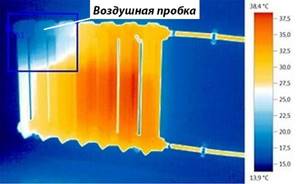
The thermal image shows the area of the heating device where an air bubble usually lingers.
Advice from professionals
A few tips from professionals will help you safely ventilate the system and reduce the likelihood of blockages:
- Always add water to the cooled autonomous heating circuit from the lowest point under low pressure. After topping up, turn on the boiler, heat the coolant to a temperature of 60 °C, and begin to bleed air from each battery through the Mayevsky valve. If necessary, after servicing all radiators, add more water to the system.
- The rod from the Mayevsky tap cannot be completely unscrewed. It is difficult and often impossible to screw it back in under running hot water.
- Unscrewing the radiator cap in an apartment is strictly prohibited. Central heating operates under high pressure. If the plug is torn off, all the apartments below will be flooded.
If problems arise with airing, it is best to call a specialist from a service organization who has the right to turn off the riser for repairs even during the heating season.
Application of the Mayevsky crane
Air can be released using special removable handles. They are put on the inside of the valve, which is made of metal. If such a handle is missing, it must be replaced with a notch for a screwdriver.

Mayevsky crane - a convenient device
How to properly remove air from a heating system?
- Place a container under the tap (volume – 500-1000 ml).
- Open the tap. Wait until the air comes out. Then a characteristic hiss will appear, indicating the flow of air mixed with water.
- Wait until clean water comes out.
- Close the tap.
If there is no handle, you will need to use a screwdriver or wrench. You can use a gas or adjustable wrench
If the tap is screwed on very tightly, you need to act carefully. Otherwise, you can rip it off, the consequences of which can be catastrophic.
The instructions are:
- Wrap the surface of the radiator. Use a rag or rags. Place a container to allow liquid to drain out.
- Turn off the tap and wait for the hiss to appear.
- Wait for the water to drain out.
- Drain the water (up to 2000 ml).
- Turn on the tap.
- Wait 10-12 minutes.
- Turn off the tap and make sure that the air comes out completely.
- If this does not happen, you need to repeat the procedure.

Battery plug
If there is no tap, and instead there is a Soviet-style plug, you need to proceed as follows:
- Wrap the desired area with thick fabric. You can use rags. This will eliminate the risk of high pressure.
- “Arm yourself” with a converter (can be replaced with a solvent).
- Carefully turn the plug. There is no need to take it out completely, otherwise there will be a “flood” in the apartment.
- Wait for the air masses to come out. The flow can be felt by placing your hand near the plug.
- Wait until the water flows out (3000-5000 ml).
- “Arm yourself” with fum tape and wrap the plug. The required direction is against the thread. This provides the necessary tightness.
- Screw the plug as tightly as possible.
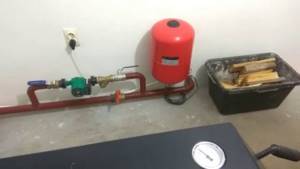
For individual heating, you can use an expansion tank
If your home has individual heating, you can get rid of the problem using an expansion tank. They can be open or closed.
In the first case, we may be talking about a decrease in the coolant or water level. They should be added to the system. It is advisable to use the bottom valve. The radiator can be absolutely anything. If this is not possible, you will need to use a tank.
After removing the air lock, it is necessary to start the system. She should do a good job. If the plug remains, it is drained using the radiator.
If the type of tank is closed, then you first need to check its functionality.
